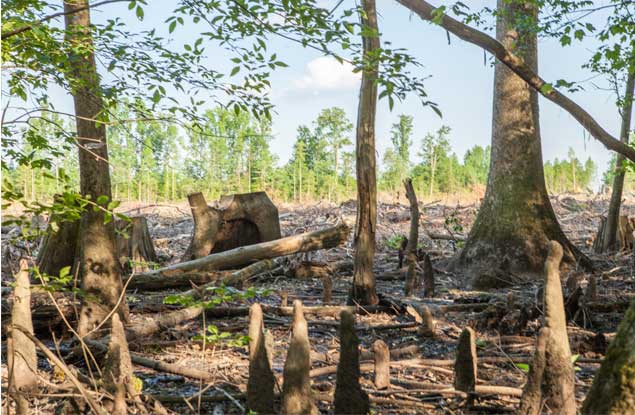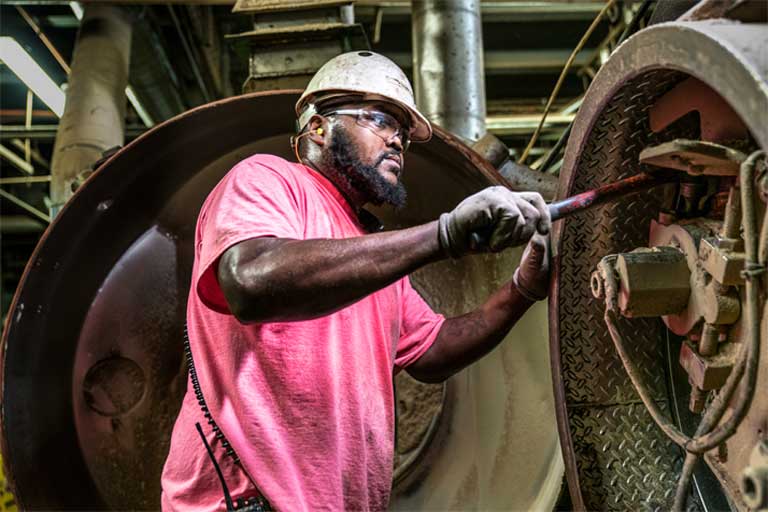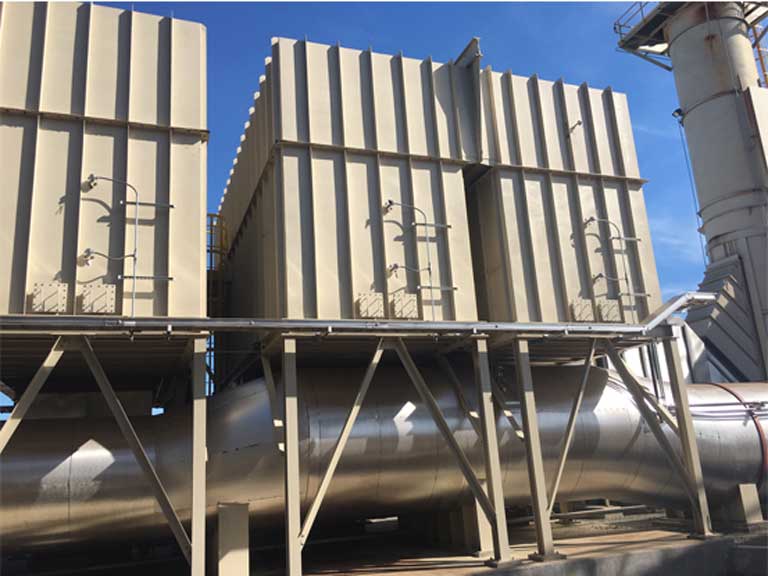- An outdated Kyoto Climate Agreement policy, grandfathered into the 2015 Paris Agreement, counts electrical energy produced by burning biomass — wood pellets — as carbon neutral. However, new science demonstrates that burning forests for energy is dirtier than coal and not carbon neutral in the short-term.
- But with the carbon accounting loophole still on the books, European Union nations and other countries are rushing to convert coal plants to burn wood pellets, and to count giant biomass energy facilities as carbon neutral — valid on paper even as they add new carbon emissions to the atmosphere. The forest industry argues otherwise.
- It too is capitalizing on the loophole, building large new wood pellet factories and logging operations in places like the U.S. Southeast — cutting down forests, pelletizing trees, and exporting biomass. A case in point are the two giant plants now being built by the Enviva Corporation in Lucedale, Mississippi and Epes, Alabama.
- Enviva and other firms can only make biomass profitable by relying on government subsidies. In the end, forests are lost, carbon neutrality takes decades to achieve, and while communities may see a short-term boost in jobs, they suffer air pollution and the risk of sudden economic collapse if and when the carbon loophole is closed.

When biomass manufacturer Enviva completes its two newest U.S. Gulf Coast plants on opposite sides of the Alabama-Mississippi state line, likely by 2021, they will be the largest “biomass for energy” manufacturing plants on the planet.
Every year, the two factories will grind the equivalent of a hundred square miles of forest into 2.7 million metric tons of combustible wood pellets, to be burned at former coal plants in Europe and Asia — with all the resulting carbon released into the atmosphere.
These U.S. biomass plants, and the wood pellets they churn out, will thrive atop a shaky Jenga tower of political, economic and environmental paradoxes, according to environmentalists. Unable to compete with carbon fuels like coal or natural gas on price, Enviva’s wood pellet plants will stay afloat because of direct and implicit subsidies coming from the European Union, whose members agreed to derive 32% of their energy from renewables by 2030 — a category that they deemed to include biomass.
The EU endorsed this policy even though recent science has shown unequivocally that wood pellets release more CO2 even than coal.

Rule of thumb: to get from the 2.7 million metric tons of wood pellets produced annually to the amount of CO2 released from smokestacks, multiply roughly by four. That means the pellets the two new Gulf Coast mills produce, when burned abroad, could project a little over 10 million tons of CO2 into the atmosphere — the equivalent of 55,000 railroad cars of coal — all while soaking up subsidies that might otherwise go to traditional renewables like wind, tidal, or solar energy, according to Duncan Brack of the Chatham House international NGO and think tank.
Those subsidies, say scientists, are based on now debunked research first conducted and used as guidance for making policy incorporated into the Kyoto Climate Agreement, a policy then grandfathered into the 2015 Paris Agreement. They say the mistake that makes biomass economically viable today is the contention that burning up the world’s forests to produce energy is carbon neutral, an inconvenient untruth that, critics contend, the United Nations has dodged facing at every annual international meeting since Paris.
And so the EU renewables quotas — with their claim of biomass carbon neutrality — have meant a boon for companies like Enviva that sell wood pellets to energy producers and countries now leery of more traditional power sources, ranging from nuclear to coal to hydropower, and who want to squeeze a few more decades out of existing coal burning power plants — now converted to burning wood pellets on an industrial scale.
Enviva has already started construction on its larger biomass plant in Lucedale, Mississippi, with a production capacity of 1.5 million metric tons of pellets per year, forty miles inland from the port at Pascagoula. Toward the end of 2019, the state of Alabama permitted Enviva’s Epes factory, which will produce 1. 2 million metric tons annually just across the state line from Meridian.

Embracing the UN’s biomass carbon neutrality error
Wood pellets are tightly compressed, processed wood products originally designed for home heating and cooking, a purpose for which they serve far better than unprocessed firewood. But since 2009, Maryland-based Enviva has built a fleet of 12 pellet mills across the U.S. Southeast, largely to meet demand for biomass energy in Britain, the Netherlands, and Denmark — nations using the UN carbon neutrality accounting loophole to reduce their greenhouse gas emissions, at least on paper.
The pellet industry has enthusiastically joined with the UN, EU, US and other nations in making “biomass carbon neutrality” claims that are controversial.
In January 2018, more than 800 scientists from around the world petitioned the European Union Parliament to strip the “carbon neutrality” designation from the wood pellet industry. They wrote: “Burning wood is inefficient and therefore emits far more carbon than burning fossil fuels for each kilowatt hour of electricity produced.” In addition, “Time matters. Placing an additional carbon load in the atmosphere for decades [while trees regrow] means permanent damages due to more rapid melting of glaciers and thawing of permafrost, and more packing of heat and acidity into the world’s oceans… The adverse implications not just for carbon but for global forests and biodiversity are also large.
The International Energy Agency, an autonomous, international trade group sometimes criticized for being bullish on fossil fuels, released a more pro-biomass report in November 2019. They wrote that “We agree that biomass derived from deforestation should not be recognized as renewable. However, forest biomass is by definition renewable if it is harvested from forests that are managed such that there is no loss of productive capacity — i.e., so that growth/harvest cycles can continue indefinitely and capacity to sequester carbon is not diminished. Sustainable forest management is key to maintaining healthy and productive forests.”

No matter the pros and cons, none of the UN parties has budged on their biomass burning policies and plans so far. And as long as EU subsidies and carbon write-offs continue flowing, Enviva can provide European nations (which need to fill a fixed “renewables” quota under local 2009 and 2018 Renewable Energy Directives), along with other Paris Agreement signatories, with the only “renewable” that can offer on-demand power utilizing existing coal-burning infrastructure with minor, and relatively cheap retooling.
In fact, Enviva CEO John Keppler told investors during an October 2019 earnings call that the company’s growth is set to increase. As European and Asian governments move off of coal, he predicted, they will be driven to move over to biomass. Coal plants were closing in Germany and the Netherlands, Keppler said on the call, South Korea had just announced it would shut down ten coal plants by 2022; all this, he predicted, would mean boom times for biomass.
In a prior earnings call, he predicted Enviva would more than double current wood pellet production capacity, developing as many as 13 new plants, to meet Asian demand.
All great news for Enviva investors. However, the carbon accounting loophole could help Paris Agreement signatories appear to meet their renewables quotas, while shooting vast amounts of carbon skyward, further destabilizing the global climate now while smashing the possibility of meeting the UN’s own stated goal of avoiding catastrophe by staying below a rise of 1.5 degrees Celsius over pre-industrial average temperatures.

More and better jobs in a dirtier world
Carbon neutrality aside, when Enviva talks about the benefits of the Epes and Lucedale plants to locals, it falls back on the hoary rationale extractive and industrial projects have used for decades: jobs.
“When we develop a new project in the [U.S.] Southeast,” Enviva spokesperson Maria Moreno wrote, “we are welcomed. ” Enviva points out that it offers jobs in rural counties where they are in short supply.
But along with pellet production jobs — as towns from Virginia to Florida have learned first-hand — has come loss of natural forests, along with pellet pollution: a cloud of soot and fine particulate matter that coats nearby houses and cars; as well as volatile organic compounds and nitrous oxide bad for public health, along with road noise made by streams of rumbling logging trucks. Thanks in part to these concerns, in 2019 Enviva settled with North Carolina, agreeing, after years of operation, to install industry-standard pollution controls.
One advocate who has pushed for reforms to Enviva’s operations in North Carolina is Patrick Anderson, an attorney with the Environmental Integrity Project (EIP), a network of public interest lawyers who take on environmental cases. In 2018, Anderson and his law-firm partner and boss, Keri Powell, released a report showing how the biomass industry had long evaded the US Clean Air Act (CAA), largely through creative interpretation of the CAA’s distinction between “major” and “minor” pollution sources.


Even among pellet plants, Enviva is “a clear outlier,” Anderson told Mongabay, in areas ranging from the huge size of its plants, its failure to initially install industry-standard pollution controls, and its willingness to fight for years to avoid ever having to install those measures, even though other pellet plants use them.
Following the EIP report, certain states — Georgia, North Carolina, Virginia — acted quickly to regulate their states’ pellet industry. But their neighbors in Alabama and Mississippi, still new to the pellet industry and known for their race to the bottom regarding environmental regulation, have been slower.
When I met Anderson last May, he was recently returned from a Lucedale meeting that had ostensibly been about Enviva’s air quality permit. But very few speakers, Anderson recalled, had anything to say about emissions. What they wanted to talk about was jobs — as loggers, as plant workers, as port workers. At one point, a speaker led the packed room in chanting “Jobs, Jobs, Jobs!”

Evaluating profit and loss
But at what price, these jobs? Rita Frost, an organizer at the North Carolina-based Dogwood Alliance, an NGO which opposes further growth of the pellet industry, told Mogabay that the ”jobs” tagline has a very old pedigree. “In the South, that’s what the extractive industry does. They promise the world to state and local governments, they extract resources, they [export] them across the world, and then they leave.”
In fact, the game already appears to be playing out that way, with mounting costs to local communities. In many small rural counties (from Southampton, Virginia; to Ware County, Georgia; to Sumter County, Alabama) not only have elites seen in wood pellets a chance to revitalize their crumbling manufacturing and export base. They’ve also been willing to pay handsomely for the privilege — with money coming out of taxpayers’ pockets.
The plant in Lucedale, for example, promises 90 good jobs, as well as an uptick in gig work for hundreds of loggers living within 75 miles of the plant, plus more gigs for truck drivers hauling logs and pellets, along with increased employment for port workers in Pascagoula.
But the Lucedale plant is estimated to cost $140 million in total; while the port upgrades that will allow the pellets to be freighted to Europe or Asia will cost another $90 million. In Mississippi, Enviva’s Lucedale plant will get $4 million in direct government grants and $13 million in waived taxes, which the Mississippi Center for Public Policy estimates will cost $188,000 per job over the next ten years. And there is a lot of evidence that tax incentives generally don’t net any money for counties and states that offer them.
The biomass industry argues back that the subsidies are absolutely necessary to get the wood pellet movement off the ground — a movement they claim to be “green” despite scientific evidence otherwise. Taylor Fitts of the USIPA, (the US Industrial Pellet Association), a wood pellet trade group, wrote in a statement that biomass development would be impossible without state and local subsidies, plus others potentially coming from the US and other UN member nations; money flooding through the carbon accounting loophole (benefiting an industry that I and my colleague Justin Catanoso have covered here and at the Raleigh News & Observer).
Importantly, those subsidies don’t only arise on this side of the Atlantic. Most of Enviva’s exports go to just one power plant: Drax, in the north of England, a giant coal-to-wood pellet converted plant which provides 10% of British electrical demand. The pellets are paid for with about $1.2 billion per year in UK subsidies — subsidies which, in turn, absolutely depend on the notion that biomass is green, carbon-neutral fuel.

A future of uncertainty
So if pellet-purchasing utilities and/or investors stop believing in biomass carbon neutrality — or if the UN at last closes the carbon accounting loophole, or the EU rejects it — then biomass suddenly becomes a very bad bet, with the industry in real danger of going from boom to bust overnight. That’s because, if biomass is properly classified as a carbon fuel, it can’t likely compete against fracked natural gas which is cheaper and cleaner.
In nearby Texas, the city of Austin — just east of the great natural gas frack fields of the Permian basin — recently paid $460 million to get out of a biomass contract. Drax, for its part, which bills itself as “dedicated to enabling a zero carbon, lower cost energy future,” is already hedging its bets and investing heavily in natural gas plants across England. Because, as Rita Frost of the Dogwood Alliance bluntly puts it: take away the subsidies and “all this could just go away.”
Lucedale, Mississippi, and Epes, Alabama, are taking no such precautions. These communities stand to lose everything, having put their full trust in forestry industry promises and a UN policy that allows pellet companies to brand forests — carbon-storing, ecologically priceless, flood-preventing forests — as “low-value” or “waste wood.”
Confronted with grim environmental and economic long-term forecasts, Enviva and USIPA responded that the “wood basket” remains a major employer in the Southeast, providing billions of dollars to the states. On top of that, the forests are “overstocked” with wood that needs to be cut, an old saw of the forestry industry, which, Moreno wrote, remains “a mainstay of rural economies.”
This industry argument identifies a new promise — wood pellets — as the salvation of rural communities, just as it did a century ago when promoting the now largely vanished furniture, tool, and paper manufacturing businesses.
These boom and bust businesses went away because the market and supply chain patterns shifted, and there are initial signs that a parallel shift could already be underway now for pellets. In the UK, the mainline Committee on Climate Change argues that the nation should move “away from large scale biomass burning” and the subsidies that support it. Prominent EU officials have also announced plans to put the carbon loophole under critical review. And recent high-profile media reports in Denmark and the Netherland have linked the pellet industry to the clearing of vital carbon-storing forest stands in the U.S. Southeast, threatening the ethical and economic underpinnings of the biomass industry.
The risk to Enviva and those it enlists to follow the biomass path, is that wood pellets will suddenly lose their “sustainable” and “carbon-neutral” status. Then the excited Mississippians chanting “Jobs!” could once again find themselves unemployed, left with broken industry promises, and yet more shuttered factories in a blighted landscape.
By then, though, a decade or more may have passed: by then, millions of tons of carbon now locked in trees will have been loosed to the atmosphere from Drax and other pellet burning plants. Meanwhile, forests that now hold down Gulf Coast bottomlands against devastating floods will have been reduced to saplings, struggling up against the maelstrom of a warming world.
Banner image: Enviva’s pellet plant in Sampson County, North Carolina, from the air. This facility is less than half the capacity of the Lucedale plant. Image courtesy of the Dogwood Alliance.
FEEDBACK: Use this form to send a message to the author of this post. If you want to post a public comment, you can do that at the bottom of the page.
